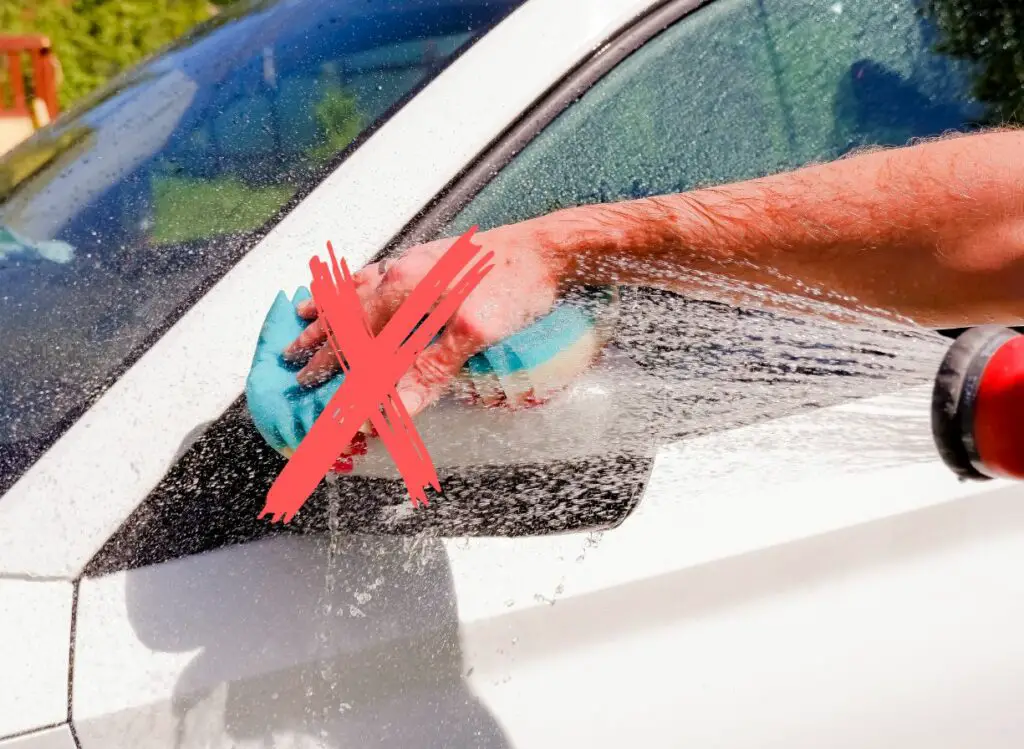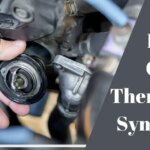
You’re dead wrong if all that’s necessary to clean your car is a sponge and dishwashing soap. Why you should never use a sponge to wash your car? In reality, sponges are bad news: they’re ineffective for removing dirt, can scratch paint finishes and leave swirl marks, harbor bacteria if not cleaned or replaced often, and the rough side of the sponge can actually do more harm than good. In this article, I’ll explain why and give you alternative options.
Table of Contents
The Downside of Using a Sponge for Car Wash
Using a traditional sponge for car washing can have several downsides and potential risks. While sponges are commonly used for their ability to hold water and create suds, they can also cause scratches, swirl marks, and paint damage if not used properly. Here are potential issues associated with using sponges for car wash:
Scratches
Traditional sponges, especially those with a rough surface or worn-out edges, can contain dirt, sand, or debris that can act as abrasive particles. When you apply pressure and move the sponge across the car’s surface, these particles can cause fine scratches. Over time, these scratches can accumulate and affect the vehicle’s overall appearance.
Swirl Marks
Swirl marks are circular or semi-circular scratches visible under certain lighting conditions, especially on darker-colored cars. These marks are typically caused by improper washing techniques, such as using a sponge in a circular motion or applying too much pressure. Sponges, due to their texture, can contribute to the creation of swirl marks if not used correctly.
Paint Damage
The paint on a car’s surface is delicate and easily damaged. Sponges, especially if they are not clean or if they have hard particles embedded in them, can cause micro-scratches or even remove small portions of the paint. This can lead to paint degradation and dullness or expose the underlying metal to the elements, increasing the risk of rust.
Why You Should Never Use A Sponge To Wash Your Car
Sponges – If You Must, But Not Recommended
Paint manufacturers warn against using sponges because they can scratch paint and leave behind swirl marks, even if you use a soapy sponge designed for cars.
Plus, soapy water alone isn’t enough to break up and lift dirt. And microfiber sponges can also scratch the paint.
The swabs used in some interior detail kits are made of microfiber and designed to be used with a cleaning solution, preferably one that includes a clay bar. But these aren’t for buffing paint; they’re for spot-cleaning plastic and rubber parts like vents, door handles, and dashboards.
The Worst Use Case for a Sponge – Your Paint
Do not use a sponge to apply car polish or wax: you could scratch your finish. Never let a sponge touch your paint—ever. If you do, wash it, dry it thoroughly and never reuse it.
Check out: How to wax your car with an electric buffer?!
According to experts, microfiber sponges are widely thought to be a health risk since many contain synthetic fibers that are now shown to cause allergies and asthma.
If you’re still convinced that sponges are harmless because they’re soft, bite your tongue for thinking that should be an empty claim.
The Best Use Case for a Sponge – Your Wheels
So, what parts of the car should be washed with a sponge? Wheels!!! This is the only decent use for a sponge: the wheels and hubcaps, which you should wash by hand with a commercial wheel cleaner that’s safe for all finishes. Some products include tire foam to clean wheels, but this can damage paint and rubber parts.
I bet you now know the answer to the question “Should you wash your car with a sponge?”.
Alternatives to Sponge Car Washing

Knowing the potential risks that a sponge can cause for your car paint, you might ask: If it’s not ok to wash my car with a sponge, what’s best to use? Here are some recommendations from car experts:
The Best Choice: A High-Quality Wash Mitt Made of Microfiber
While your local auto supply store may carry a wide variety of mitts, not all are the same when it comes to car washing. You should stick with those that are made for car washing and have the highest grade of microfiber fibers.
If too many particles are in the weave, the mitt will not be as soft or plush on your car’s finish.
When looking at wash mitts, check the stitching to see if it’s tight and secure. The tighter the stitching, the more durable and long-lasting the car wash mitt.
There are many things called microfiber, but the ones made of polyester or rayon that you see in the stores today aren’t good for car cleaning. Wash your car with microfiber towels and wash mitts instead.
Microfiber is a synthetic fabric that’s strong and soft, making it ideal for cleaning car interiors because it doesn’t scratch surfaces. It’s also very gentle on paint finishes and rubber and plastic parts. The tight weave of microfiber absorbs dirt and water, which is a key reason why it’s a perfect choice for washing cars.
The only drawback is that it’s not very durable; it shreds easily when dry so you have to wash by hand and line-dry.
Find out: How often can you wash your car in winter?!
You can’t go wrong with a microfiber mitt. It’s the best way to clean your car from top to bottom, including its bumpers, wheels, mirrors, paint finish, and glass surfaces.
The Second Option: Synthetic Chenille Wash Mitts
Synthetic Chenille Wash Mitts are specialized cleaning tools designed for washing cars. They are made from synthetic materials, typically polyester or microfiber, and feature a unique chenille construction. The term “chenille” refers to the textured fabric used to make the mitts.
Chenille wash mitts consist of long, looped fibers that resemble the appearance of caterpillar fur. These fibers are highly absorbent and create a soft and plush texture. The loops in the fabric help to increase the surface area of the mitt, enhancing its cleaning power and dirt-trapping ability.
The synthetic materials used in Chenille Wash Mitts offer several advantages. They are durable, resistant to wear and tear, and can withstand repeated use. The synthetic fibers are also less likely to harbor dirt or debris, making them easier to clean and maintain.
The design and construction of chenille wash mitts make them suitable for gentle and effective car washing. The soft and plush texture ensures a smooth glide over the car’s surface, minimizing the risk of scratches or swirl marks. The mitts’ absorbent properties allow them to hold a significant amount of water and soap, facilitating the washing process.
Check out this video for how to select the right car wash mitts!
Another Great Option: Foam cannons and pressure Washers
Foam cannons and pressure washers are powerful tools that offer numerous advantages over using a sponge for car washing. Here’s why they are considered superior:
Enhanced Cleaning Efficiency
Foam cannons and pressure washers generate a high-pressure stream of water and soap foam, which can quickly and effectively remove dirt, grime, and other contaminants from the car’s surface. The force of the water helps to dislodge stubborn particles that may be difficult to remove with a sponge alone.
Thorough and Even Coverage
When paired with pressure washers, foam cannons create a thick layer of foam that clings to the car’s surface. This foam helps to loosen and encapsulate dirt, allowing it to be easily rinsed away. The foam also ensures thorough coverage, reaching into crevices and difficult-to-reach areas that sponges may miss.
Minimized Risk of Scratches and Swirl Marks
Foam cannons and pressure washers reduce the need for physical contact with the car’s surface. A sponge has a higher risk of trapping dirt and debris, which can cause scratches when rubbed against the paint. Using foam cannons and pressure washers can significantly minimize the risk of scratches and swirl marks.
Time and Effort Savings
Foam cannons and pressure washers allow for quicker and more efficient car washing. The high-pressure stream and foam coverage reduce the need for manual scrubbing, which can be time-consuming and physically demanding. With foam cannons and pressure washers, you can complete the car wash process quickly and with less effort.
Read More: How to Wash a Car Without Scratching the Paint
Using a Brush on Car Paint
If you must use a brush on your car, never use a brush made of natural fibers. Synthetic brushes are the best choice, but the bristles should be made of nylon or polyester.
The bristles should not be too hard or too stiff and should ideally have a natural curve at the tips so they can conform to your car’s body panels without damaging them.
Avoid bristle brushes with sharp edges that can scratch the paint.
Frequently Asked Questions

#1 Is Sponge Good for Cleaning Car?
Many people use sponges to clean their cars. But many car experts say that a sponge is not good for cleaning because the rough side of the sponge can scratch the paint surface. And a synthetic type of sponge can leave fibers on your paint finish and make it look dull.
#2 Is Sponge Good for Applying Wax?
As we know, wax is a protective coat of paint finish. Using a sponge to apply wax will leave some fibers on your paint finish and make it look unappealing.
#3 Is Sponge Good for Rubbing off Wax?
Many people use a sponge to rub the wax off the paint finish on their car. But the sponge scratches the paint surface and creates swirl marks.
#4 Is Sponge Good for Polishing Car?
Many people use a sponge to polish their cars. But it may leave scratches on your paint finish because it’s too rough, and natural fibers won’t polish your car.
#5 Is Sponge Good for Cleaning Car Interior?
Many people use a sponge to clean the car’s interior. But it would be best if you avoided microfiber sponges because those made of natural fibers may cause allergies and asthma. Instead, use a soft microfiber towel.
#6 Will a Sponge Scratch My Car?
Yes, a sponge can scratch your car if not used properly. When pressure is applied during washing, abrasive particles like dirt or debris in the sponge can cause fine scratches. Using a high-quality, soft sponge, pre-rinsing the car, and gentle motion can minimize the risk.
However, alternative methods like microfiber wash mitts or foam cannons with pressure washers are safer options to avoid scratching.
#7 Can kitchen sponges scratch cars?
Yes, kitchen sponges can potentially scratch cars. They are often rough and can contain abrasive particles that may scratch the car’s surface when used for washing. It is recommended to use sponges specifically designed for car washing or alternative tools like microfiber wash mitts or foam cannons to minimize the risk of scratching.
What items should I use to wash a car?
To wash a car effectively and safely, you can use the following items:
- Microfiber wash mitts or towels are gentle on the car’s surface and have excellent dirt-trapping capabilities.
pH-neutral car wash soap: Specifically formulated for automotive use, it helps to break down dirt and grime without damaging the paint. - Grit guards: Placed at the bottom of your wash bucket, they help prevent dirt and debris from contaminating the wash mitt or sponge.
- Hose or pressure washer: Used to rinse the car before and after washing.
Check out this video for how to use foam cannon to wash a car!
What shouldn’t I use to wash my car?
Avoid using the following items to wash your car, as they may cause damage:
- Kitchen sponges or abrasive brushes: They can scratch the car’s surface.
- Dish soap or household cleaners can strip away the protective wax and damage the paint.
- Dirty or contaminated towels can introduce dirt particles and scratch the paint.
How can I properly maintain microfiber towels?
A good microfiber towel is crucial in keeping our car spotless. To maintain microfiber towels in good condition, follow these tips:
- Wash separately: Wash microfiber towels separately from other fabrics to prevent lint transfer.
- Use a gentle detergent: Avoid using fabric softeners or bleach, as they can reduce the towel’s absorbency.
- Wash in cold or warm water: Hot water can damage the fibers.
- Skip the dryer or use low heat: Air drying or using a low-heat setting is recommended to prevent melting or shrinking.
- Avoid using towels on rough surfaces: Microfiber towels can pick up abrasive particles, so avoid using them on rough or dirty surfaces to prevent potential scratches.
Conclusion
So, now you know we never use sponges for washing cars. If you still insist and using a sponge, then line-dry it. And if you make any mistake with your car, do not hesitate to contact us immediately because we will be glad to answer all your questions.
Read more: Things to know when washing your black cars?!
Hi everyone, My name is Ollie Barker.
As a seasoned auto expert I have 25 years of experience working in repair and detailing shops. I love to share my tips & tricks to all car lovers, so that’s why I’m here at Automotive Gearz publishing my content, sharing my passion. Also, I’ve been giving my recommendations on which products are the best to have on the market. I always thought it was hard to pick the right part, so hopefully I can make that a bit easier for you.
Hope you enjoy your time on my little blog!







